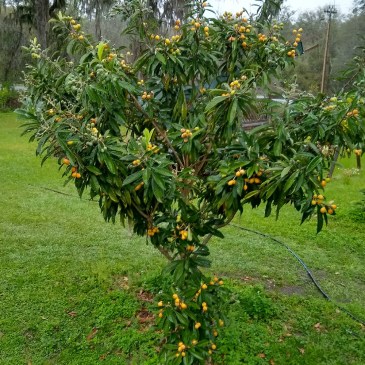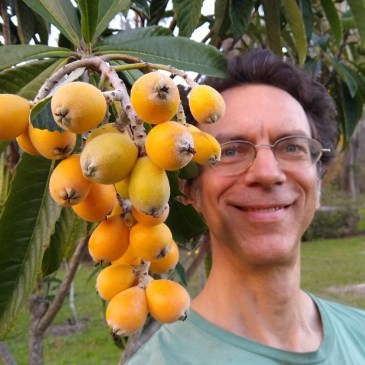
The loquat trees here in North Florida are having an outstanding fruit crop this year. It’s especially impressive to see the abundance, size, and sweetness of the crops happening right now on the improved, named-variety trees which a number of us have been planting in this area for the last few years.
Loquat (Eriobotrya japonica), originally native to China, is commonly planted in this area as a landscaping tree – the large, stiff, evergreen leaves make it a desirable specimen tree. But many people love this tree even more for the sweet-tart yellow orange fruits that ripen on it from late winter to early spring most years.
Loquat fruits seem especially popular with children. I’ve heard many people tell me with great affection about how they grew up climbing the loquat trees every year in search of these sweet treats. In this area, some people know the fruit by the name loquat, some people know it as Japanese plum, but it seems that everyone who grew up eating it in their early years has a deep fondness for it.
The loquat trees used in landscaping have typically not been selected for their fruiting abilities, and so their fruit quality is variable: fruits on these trees are usually smallish, some are sweet, and some are quite tart. Occasionally I’ve run into a seedling loquat tree that makes fruits which are devoid of any sweetness or fruity flavor at all – they’re pretty much just sour, and that’s it.

But a number of named-varieties loquat cultivars exist that people have selected for their ability to make larger, sweeter fruit. Some of these include ‘Novak’, SES2, ‘Gold Nugget’, ‘Champagne’, ‘OKT’, ‘Tory’, ‘Christmas’, and ‘Shambala’.
People propagate these improved cultivars by grafting them onto seedlings, or occasionally by air-layering them. While these vegetative propagation methods are the way to ensure you’re producing new trees with the exact genetics of the parent, we’ve also found that seedlings of the named varieties tend to produce fruit that’s above-average as well.
Loquat trees flower over the autumn and winter, and the fruits develop right through the coldest parts of winter. Light frosts don’t cause them a problem, but a hard freeze during this period of fruit development can cause fruit malformation, or that year’s crop may get destroyed altogether if the cold snap is especially severe. Loquat trees themselves can handle cold down to about 12F (-11C), but temperatures much below about 25F (-4C) risk fruit damage. So during years when we’ve gotten an especially cold winter in this area, we get few or no loquats the following spring.
Fortunately this year’s winter so far has been extraordinarily mild here. There have been a number of very light frosts, but not even enough to cause significant damage to banana leaves. That, combined with the abundant rainfall we’ve gotten over the last year, is powering an abundant crop of fruit on the local loquat trees. Some trees have been ripening fruit since the middle of January, and some are still loaded with half-size green fruits as of the time of this writing (late Feb), so it looks like this abundant crop is set to keep ripening for quite a number of weeks to come.
I admit, in the past I’ve sometimes thought of loquat as kind of a minor fruit, something sweet to nibble on after the main citrus season has passed. But I’ve been thoroughly impressed at what a great experience it can be to eat well-developed fruits on some of the improved variety trees, especially when they are ripened to perfection (hint: when loquats are yellow, they’re still tart. Wait till they’re golden orange for sweetest flavor).

I describe the taste of a good loquat as being 75% like eating a peach, and the other 25% a mix of the flavors of cherry, pear, and mango. This is really an excellent fruit.
I had been planning on including a few loquat trees in my fruit grove, but based on these recent favorable experiences, I’ve decided to boost that planting substantially. I have a number of seedling loquat trees in pots, and the last couple of weeks I’ve been grafting them over to the improved varieties. I hope that in a few years, I’ll be able to have quantities of this excellent fruit for sale, as part of the diverse mix of fruits I’m planting on my property.
If you live in a climate where loquat trees can grow and fruit, I recommend planting out improved varieties. There are three ways to do this:
- Finding a nursery that sells named-variety, grafted loquat trees, and buy some of these improved types to plant out.
- Learn how to graft, and get budwood from the improved types to graft onto seedling trees in your area. Loquats are pretty easy to graft (look up the side-veneer grafting technique – works well for this fruit tree).
- Simply get fruits from named-variety trees and plant the seeds from those fruits. They won’t be exactly identical to the parent trees, but on average they’ll make large, sweet fruits. Some seedlings from named-variety trees might make fruits better than any loquat variety now in existence.
There are a lot of the loquat trees in Charleston but I have never tried making jelly with them. Do I have to peel them like you do kumquats?
If anyone has a recipe for preserves or jelly, please let me know.
Thank you 😊
LikeLiked by 1 person
Thanks for commenting! I’ve never tried making loquat jam or jelly, but I bet they’d be great for that. When I eat loquats, I eat them skin and all. I’m not positive, but there might be a post on the blog suwanneerose.com about making loquat jam.
LikeLike
Hello, do you know where I can buy loquat fruits in Gainesville or areas in the proximity? Thanks!
LikeLike
Yes! My neighbor Lyle has a number of loquat trees of improved varieties, and he’s selling the fruits at his booth at the downtown farmers market, Wednesdays at 4-7pm. Booth name is Weaver’s Whimsy Farm. The loquats often sell out quickly, so try to get there just after 4pm. I’ve heard that a couple other vendors were selling loquats at that market, but I don’t know if they have the improved varieties.
LikeLike
Im from maryland but im in orlando right now i need to but them please help me
LikeLiked by 1 person
Hmm, I don’t know offhand of where to buy loquat fruits in Orlando. You might try checking out farmers markets. Also, look for loquat trees around: they’ve got big, stiff, green eliptical leaves, and right now they’re covered in yellow-orange fruits. You might be able to forage some fresh-off-the-tree loquats for free.
LikeLike
stupid question…can they be purchased at stores? Can they be grown in pots?❤️️☺️❤️️
LikeLiked by 1 person
Not stupid at all. In areas where loquats grow (west & southern parts of US), they sometimes show up at farmers markets. Elsewhere, I’ve heard reports of them VERY occasionally showing up in produce sections. Loquats are native to China and Japan, so it wouldn’t surprise me if they show up in Asian grocery stores.
If you buy a grafted loquat tree, it can make a few fruits growing in a pot, but not nearly as many as it can produce growing in the ground.
LikeLike
I’m in So. Ca…so it would grow here. I haven’t seen it at the home improvement stores, but maybe I didn’t notice. I was in search of a pom. Thanks again for the info!
LikeLike
Very nice to see blogs on this fine fruit. I personally grow the best of all the Exotics that we can grow here in Florida and this is one that should not be passed up for the front of your home where you still need a certain Majestic appeal. I saved the anona for the side of my house where they cannot be seen and the mango Grace the backyard. These are the best of the best of exotic fruit trees for visual appeal.
LikeLike
There so many that have bloomed where I live, but I’m afraid of eating the. Orlando, Florida
LikeLike
Craig, I am in N.W. Ohio.. I know I can’t grow some fruit trees here. I went to Israel & brought back olive pits from Gethsemene.. and carefully cracked the pit, and plant the seed with a prayer filled heart.. and to my amazement & thrilled heart, I have a 12 inch tall olive tree in a pot.. I don’t let it outside, because I am afraid of insects getting it. It is now 5 years old, and I will transplant it into a larger pot.. Do you have advice for me? Would it like composted pine needles? Or coffee grounds? I LOVE THIS TREE! Mary Lou
LikeLiked by 1 person
That’s so great that you were able to grow a little olive tree from the pots from Gethsamane! I’m not much of an expert on growing olive trees. I’ve seen people grow them in the acidic sand we have here in North Florida, and also in more alkaline soils. So they seem adaptable to different soil types. Probably a general potting soil would be fine – you could mix in some composed pine needles and a bit of coffee grounds, and top off the pot occasionally with coffee grounds for fertilization. Couple things I’ve noticed about the olive trees in my area – despite our populations of voracious insects, the trees get virtually no insect damage of any kind, and they grow better with more sun. So you might consider keeping your little olive tree outdoors for the summer, as long as you can make sure to water it regularly (pots in sun outdoors dry out much faster than indoors).
LikeLike
So happy that I came across your blog. Planted my first loquat tree yesterday. I tried the actual fruit a month ago and can’t get the taste out of my mind. Delicious!!!
Smileandtravel.com
LikeLike